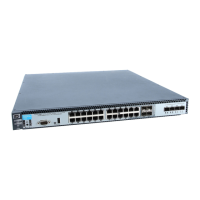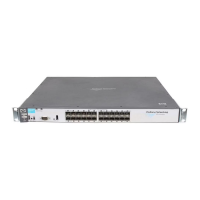270
• For compatibility, the device by default ignores the Router-Alert option and processes all received
MLD messages, no matter whether the MLD messages carry the Router-Alert option or not.
• To enhance device performance, avoid unnecessary costs, and ensure protocol security, configure
the device to discard MLD messages that do not carry the Router-Alert option.
Configuring Router-Alert option handling methods globally
Ste
Command Remarks
1. Enter system view.
system-view
N/A
2. Enter MLD view.
mld N/A
3. Configure the interface to
discard any MLD message
without the Router-Alert
option.
require-router-alert
By default, the device does not
check MLD messages for the
Router-Alert option.
4. Enable the insertion of the
Router-Alert option into MLD
messages.
send-router-alert
By default, MLD messages carry
the Router-Alert option.
Configuring Router-Alert option handling methods on an interface
Ste
Command Remarks
1. Enter system view.
system-view
N/A
2. Enter interface view.
interface interface-type
interface-number
N/A
3. Configure the interface to
discard any MLD message
without the Router-Alert
option.
mld require-router-alert
By default, the device does not
check MLD messages for the
Router-Alert option.
4. Enable the insertion of the
Router-Alert option into MLD
messages.
mld send-router-alert
By default, MLD messages carry
the Router-Alert option.
Configuring MLD query and response parameters
On startup, the MLD querier sends MLD general queries at the startup query interval, which is
one-quarter of the MLD query interval. The number of queries, or the startup query count, is user
configurable.
After startup, the MLD querier periodically sends MLD general queries at the MLD query interval to check
for IPv6 multicast group members on the network. You can modify the query interval based on the actual
condition of the network.
The MLDv1 querier sends MLD multicast-address-specific queries at the MLD last listener query interval
when it receives an MLD done message. The MLDv2 querier sends MLD
multicast-address-and-source-specific queries at the MLD last listener query interval when it receives a
multicast group and multicast source mapping change report. The number of queries, or the last listener
query count, equals the robustness variable (the maximum number of packet retransmissions).
A multicast listening host starts a timer for each IPv6 multicast group that it has joined when it receives an
MLD query (general query, multicast-address-specific query, or multicast-address-and-source-specific

